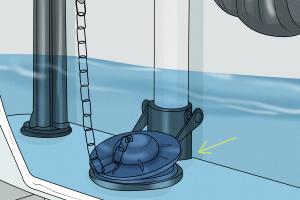How to Detect Toilet Leaks: A Comprehensive Guide for Homeowners

-
Quick Links:
- Introduction
- Why Toilet Leaks are Problematic
- Signs of a Toilet Leak
- How to Check for Leaks
- Common Types of Toilet Leaks
- Tools Needed for Leak Detection
- Step-by-Step Guide to Detecting Toilet Leaks
- Case Studies
- Expert Insights
- FAQs
Introduction
Toilet leaks are one of the most common plumbing issues faced by homeowners. Often unnoticed until they cause significant damage or inflate water bills, detecting a toilet leak promptly is crucial for maintaining a healthy home environment and conserving water. This comprehensive guide will provide you with all the knowledge necessary to identify, assess, and resolve toilet leaks efficiently.
Why Toilet Leaks are Problematic
Toilet leaks can lead to various problems, including:
- Increased Water Bills: Even small leaks can waste gallons of water daily, resulting in higher utility costs.
- Water Damage: Persistent leaks can cause water damage to floors, walls, and even the foundation of your home.
- Mold Growth: Damp areas caused by leaks can promote mold growth, which poses health risks.
Signs of a Toilet Leak
Identifying a toilet leak can be straightforward if you know the signs. Here are some common indicators:
- Unusual sounds such as hissing or running water.
- Constantly cycling toilet tank.
- Water pooling around the base of the toilet.
- Fluctuating water bills without increased usage.
How to Check for Leaks
There are several methods to check for leaks in your toilet. The following techniques can help you determine if your toilet is leaking:
Visual Inspection
Start by visually inspecting your toilet for any signs of leaks, such as:
- Water on the floor around the base.
- Corrosion or rust on the toilet tank or bowl.
Food Coloring Test
One of the simplest methods to check for leaks is the food coloring test:
- Add a few drops of food coloring into the toilet tank.
- Wait for 30 minutes without flushing.
- Check the bowl; if the color appears, you have a leak.
Tank Water Level Check
Another effective method involves checking the water level in the tank:
- Remove the tank lid.
- Observe the water level; it should be about 1 inch below the overflow tube.
- If it’s too high, adjust the float mechanism to prevent overflow.
Common Types of Toilet Leaks
Understanding the types of leaks can help you diagnose the problem more effectively:
- Flapper Valve Leaks: Often caused by a worn flapper, leading to water seeping from the tank to the bowl.
- Fill Valve Leaks: Water may leak from the fill valve, typically due to debris or damage.
- Wax Seal Leaks: Found under the toilet, these leaks can cause water to seep onto the floor.
Tools Needed for Leak Detection
To accurately detect and fix toilet leaks, you will need the following tools:
- Screwdriver
- Adjustable wrench
- Food coloring
- Bucket
- Towels or rags
Step-by-Step Guide to Detecting Toilet Leaks
Follow these steps to detect and address toilet leaks:
- Perform a visual inspection.
- Conduct the food coloring test.
- Check the water level in the tank.
- Inspect the fill and flapper valves for wear.
- Look for any water pooling around the base.
Case Studies
To illustrate the importance of leak detection, here are a couple of case studies:
Case Study 1: Residential Water Waste
A homeowner discovered a leak in their toilet after noticing a $50 increase in their water bill. After performing the food coloring test, they found that the flapper valve was not sealing properly, resulting in daily water loss of approximately 70 gallons.
Case Study 2: Mold Growth Incident
In another instance, a leaking wax seal caused moisture buildup, leading to mold growth in the bathroom. The homeowner had to spend over $2,000 on mold removal and repairs, which could have been avoided with timely leak detection.
Expert Insights
Experts recommend regularly checking your toilet for leaks as part of your home maintenance routine. According to plumbing specialist Jane Doe, “Identifying leaks early can save homeowners significant costs in repairs and water expenses.”
FAQs
1. How can I tell if my toilet is leaking?
Look for signs like water pooling around the base, unusual sounds, or perform a food coloring test.
2. What causes toilet leaks?
Common causes include worn-out flapper valves, faulty fill valves, and damaged wax seals.
3. How do I fix a leaking flapper valve?
Replace the old flapper with a new one, ensuring a proper fit for sealing.
4. Can I fix a toilet leak myself?
Yes, many leaks can be fixed by homeowners using basic tools and DIY methods.
5. How much water can a leaking toilet waste?
A leaking toilet can waste anywhere from 30 to 200 gallons of water per day.
6. What is the best way to prevent toilet leaks?
Regular maintenance and timely replacement of worn parts can help prevent leaks.
7. Are toilet leaks common?
Yes, toilet leaks are quite common and can occur in any household.
8. How often should I check for toilet leaks?
It’s advisable to check for leaks at least once a year.
9. What tools do I need to check for toilet leaks?
You will need a screwdriver, adjustable wrench, food coloring, and towels for cleanup.
10. When should I call a plumber?
If you cannot locate or fix the leak yourself, it’s best to call a professional plumber.
Random Reads